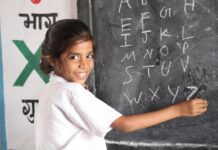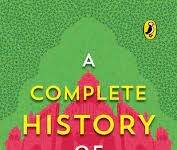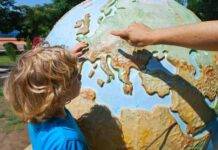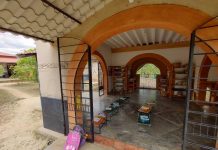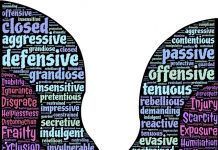History is often the most dreaded subject as the learner finds it difficult to associate herself with it. Can adequate pedagogic tools be discovered which allow the learner to develop a genuine interest in the subject? The piece that follows throws light on this pedagogic challenge.
Nivedita Dwivedi is working in the field of education. She has completed MA in Elementary Education from Tata Institute of Social Sciences, Mumbai.
Imagine that you are a detective. You will probably relate the nature of your work to solving jigsaw puzzles. As a detective, you will be required to put together the missing pieces and arrive at a plausible explanation of the situation/event you are examining. This explanation that you arrive at will be a theory that you will formulate, which, according to you, will be the most convincing explanation of the situation under examination. The strength of the theory you formulate will depend on the strength of the evidences that you have in support of your theory.

Now, imagine you are a historian. What kind of work do you think you will be required to do as a historian? Do you think it will have any similarity to the work of a detective as described above? Does the possibility sound too far-fetched to you? If you will pause and reflect for a while, you will actually realize how similar both tasks are. A historian is also a person who pieces together parts of a jigsaw puzzle and tries to make sense out of it. Out of the various evidences available to her, in the form of artifacts, archaeological remains, written and oral narratives, paintings, coins, and so on and so forth, a historian tries to place these in context, weighs them for their authenticity, relates them to other existing pieces of evidences and narratives, and then tries to formulate a narrative or a theory based on these, which, to her, sounds the best explanation for the situation under examination.
Again, the strength of the theory formulated depends on the strength of the evidences provided. A historian, thus, also understands that a theory that she is putting forward is not sacrosanct but is falsifiable, and thus liable to be modified or discarded in the wake of stronger counter evidences emerging. Also, since it is a theory based on her interpretation of the evidences in front of her, the historian also realizes that there may be equally plausible alternate explanations or interpretations of the same evidences, which may lead to alternate theories. Again, the strength or weakness of all such theories depends on the strength or weakness of the evidences the respective theories are based on and the interpretations provided. Thus, by virtue of the very process involved in the construction and re-construction of History, there is bound to be a possibility of the existence of multiple histories.
All of us have studied History as a subject throughout our student lives. How many of us have been encouraged to visualize it in the manner above? I am sure many of us haven’t. The above visualization is something that is provided by the Avehi Abacus Project, through its program titled ‘Sangati’. The above analogy (between the work of a detective and a historian) is drawn in the third kit of the Sangati program, titled ‘How Societies Developed’. Sangati, incidentally is a supplementary program that is being transacted with students of classes V to VII in the municipal schools of Mumbai, since 1990. It comprises of six kits, which are transacted, mostly once a week, with students of classes V to VII, by the regular school teachers. This three-year supplementary curriculum has been envisaged with a vision to fulfil the objectives of education, to ‘equip children with the knowledge and skills that they will need to face the world, to build values that will help them take care of themselves and contribute to the society they live in and to bring about a positive change in individuals and society’ (Avehi Abacus Project, 2001).
The entire curriculum is based on certain themes that are interlinked with each other. These flow logically and smoothly into each other. The journey starts with the self, understanding oneself, one’s body and the needs that all human beings possess. While the needs are common to all they are met in diverse manner and not provided for equally to all. As these needs are met by the resources provided by the earth, the second kit then moves on to ‘Our earth’ and the ‘Web of life’ that we all are a part of. The attempt here is to understand our place in the universe and how complex and prolonged the process of evolution of life on earth has been. It is hoped these inputs will form the basis of creating feelings of humility towards nature. The third kit then moves on to ‘How societies have developed’ over time, across the world. This kit encapsulates the history of human civilizations from early times to the 1950. The focus is on phenomena, structure and processes rather than on isolated events or characters. History is looked at as a collective heritage and is constantly connected with the present.
Historical events are also located in context of the geography they enfolded in adding more the layers to understanding why they happened, how the conditions prevalent in the space influenced them. The fourth kit then focusses on our society and ‘The way we live’ in the present, discussing various issues like caste, religion, gender discrimination etc., and understanding important topics like patriotism, democracy, the influence of media etc. As change is a constant and continuous phenomenon, the next kit then focusses on ‘Understanding Change’, and analyzing it better so that we can ‘create the society we want’ by developing a discerning mindset to differentiate between ‘change and progress’. The curriculum ends with a forward looking note and helps understand how to ‘Prepare for the Future’, as an individual and as a society. The entire curriculum is designed to be interactive and joyful, to replace ‘teaching’ by a voyage of exploration to discover facets of ourselves, our society and the world, to accommodate the understanding that each child thinks and learns differently, to encourage students to express their thoughts and share their life experiences, to help them cope with different situations and make the right choices and determine better futures for themselves and those around them’ (Avehi Abacus Team, Dear Teacher…, 2001).
Although, the entire Sangati curriculum is not designed based on the subject matter boundaries that our education system has devised, yet just for the sake of comparison, Kit III, titled ‘How Societies Developed’, can be related to the subject matter of History, as taught in schools. However, it has a very different take on how and why students need to be made aware of ‘History’. First and foremost, it does-not talk about one single ‘History’, but multiple histories, of kings as of common people, of wars as of their futility, of path-breaking events as of their impact – both positive as well as negative, of India as of the world. It does not limit History to dates and times, to kings and the boundaries of their empires, or does-not try to color it one way or the other. Instead, it encourages students to live it, to explore and to discover it, to go through the excitement of finding the pieces of jigsaw puzzle and trying to put them together in a way they think is most plausible. It, then, does-not discredit one arrangement of jigsaw puzzle in favor of the other, instead it gives the message that many different arrangements are possible, and all will equally have to stand the test of falsifiability. It titillates and challenges the minds of the students, encouraging them to play with ideas and look at things holistically.
At this stage, I want you to have a look at the following passage from a school History textbook. The title of the chapter is “Conflict with the Mughals”. The chapter begins as follows:
“So far, Shivaji Maharaj had successfully fought the Adilshahi; but for expanding the Swaraj, conflict with the Mughals was inevitable. The Mughals posed a great threat to the Swaraj even as it began to expand. Maharaj triumphed over this threat too. He regained his forts and territories from the Mughals. He got himself crowned. He took up a campaign of the south…”(Maharashtra State Board).
The above is a passage from the recently published ‘History and Civics’ textbook for Standard VII, by the Maharashtra State Board. The ‘History’ it intends to deliver to the students consists of one name, Chhatrapati Shivaji Maharaj, and looks at everything else in relation to this one name – how India and Maharashtra were before him, his struggle with the Mughals, his quest for ‘Swaraj’ from the ‘foreign’ Mughals, the ideal rule that he established and what happened after his death. The entire narrative of the textbook is built in terms of “Us versus them”, where Muslim rulers, especially Mughals are portrayed as foreign invaders whom Chhatrapati Shivaji Maharaj and other Hindu rulers fought throughout their lives. However it is not mentioned that Shivaji’s grand-father, father and older brother also worked for other Muslim rulers. It also never conveyed that the wars that Shivaji fought and the alliances that he made were born out of political considerations rather than religious ones. Many Hindu kings fought against him. He also had many Muslim officers holding key positions in his cabinet. Rather than acknowledge these facts, history, in this visualization, is limited to glorifying one man and his rule. Additionally, it also aims at discrediting one religious community and portraying its rulers as foreigners who invaded our nation, and how numerous struggles had to be undertaken to rid the nation of the foreign yoke. There is no attempt to look at Shivaji as a product of his times, responding to circumstances not always of his choosing. He is made to appear larger than life. Any inconvenient facts about him or narratives contrary to the dominant one are not allowed space in the pages of the textbook. History, here, is also presented as a finished product that has to be accepted as it is, completely in contrast to the alternate vision of Avehi Abacus, where it is treated as a process and a journey of exploration, waiting to be undertaken by young and curious minds.
The above mentioned are two contrasting visualizations of what ought to constitute ‘History’. One views ‘History’ as a dynamic living process, another as a static end-product that is too fragile to be tampered with in any manner and has to be taken in the form it is presented, no questions asked.
In the context of the attempts to rewrite history, Neeladri Bhattacharya states, “The past does-not come to us with a unitary truth embedded within it; the facts that historians mine do not ever speak with one single voice. As our perspectives change we look at the past in new ways, reinterpret events, discover new meanings within them, pose new questions that could not even be formulated within the limits of earlier frameworks of analysis. So historians tell different stories of the same past, refigure evidence in diverse ways in the act of rewriting history – an act that enriches the conceptions of our past.”(Bhattacharya, 2002).
So, essentially the process of rewriting and reinterpreting lies at the heart of the historical process. However, this reinterpretation needs to conform to the standards of scientific enquiry. It needs to be based on legitimate evidences. It needs to put those evidences out in the open for scrutiny and examination. The theories that are put forward need to be falsifiable. Each and every statement that is made needs to be supported by some evidence and also has to be open to challenge in the face of a counter-evidence.
The above example that I have cited from a school History textbook is culled out of the recently published History textbook for Standard VII, by the Maharashtra State Board. It was brought out as a process of rewriting and reinterpreting History, the purported aim being of making the students aware of their real ‘History’, claiming in the process that everything other than this should be deemed to be a distortion.
As is amply clear from the tone and methodology of the above process of rewriting, it is meant to be an exercise in pushing through a dominant perspective. In the extant case, Shivaji is portrayed as a Hindu ruler, whose primary focus and agenda is to rid India of foreign Muslim rule. He is portrayed as a righteous Hindu king, a bigot, protector of cows and Brahmins and hateful of all Muslims and their culture. (Several letters issued by Shivaji and by his ministers are available today, but none of these use the description of Shivaji as the protector of cows and Brahmins.)However, while putting forth these narratives, even the slightest of efforts are not made to corroborate them with any kind of evidence. It is meant to be an exercise in communal polarization. In contrast, to this lopsided and uncorroborated portrayal of Shivaji, I would just like to quote a few lines from Govind Pansare’s book, ‘Who was Shivaji?’ He states:
“Shivaji’s tolerance for Muslim religion is recorded in many ways in historical documents. A passage, taken from the Muslim historian Khafi Khan, is very eloquent in this respect….” (Pansare, 2005). He further goes on to quote the passage which talks about how Shivaji had made rules so that mosques would not be harmed, the Quran would be respected etc. He further states, “Raghunath Panditrao quotes one such command by Shivaji in his letter dated 2nd Nov. 1669. It is very clear in this respect.” (Pansare, 2005). The command quoted by him is as follows: “Shriman Maharaj (has ordained) that everybody is free to follow his religion, nobody is allowed to disturb it.” (Pansare, 2005).
The above portrayal of Shivaji, as presented by Govind Pansare is corroborated by concrete pieces of evidences. The only way to rewrite History in the wake of these could have been to convincingly challenge these evidences and provide evidences to the contrary. However, this has not even been attempted, instead the nature of the subject has itself been modified by divorcing it from the rigorous process of scientific enquiry itself.
As Neeladri Bhattacharya rightly says, “…when history is mobilized for specific political projects and sectarian conflicts, when political and community sentiments of the present begin to define how the past has to be represented – what can be told and what had to be erased, when history is fabricated to constitute a communal sensibility, and a politics of hatred and violence, then we need to sit up and protest.”As much as this is true, I would like to add here that at such times, if not always, we also need to realize and acknowledge the efforts of those who have been trying to put forward counter narratives, challenging and questioning the above process of fabricating history and providing an alternative vision, that is based on the principles of enquiry rather than a final word that is considered to be sacrosanct. In such a vision, the values of today are tested on the anvil of the past values and vice versa making them the stuff of real life and not as the deified glorious past or a binary of good vs evil. Avehi Abacus Project and ‘Sangati’ are the living embodiments of such a vision.
References
Avehi Abacus Project. (2001). Dear Teacher…. Myself, My Body, Our Needs : Sangati Kit I. Mumbai, Maharashtra: Avehi Abacus Project.
Bhattacharya, N. (2002). The Problem. Seminar, 122-128.
Maharashtra State Board. (n.d.). Conflict with the Mughals. In M. S. Board, History and Civics: Class VII.
Pansare, G. (2005). Who was Shivaji? In G. Pansare, Who was Shivaji? Mumbai: Prakash Viswas
This article is published in The New Leam, OCTOBER 2017 Issue( Vol .3 No.29) and available in print version. To buy contact us or write at thenewleam@gmail.com


